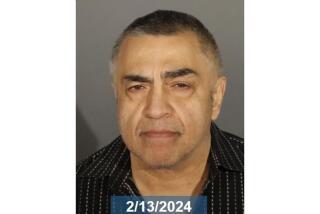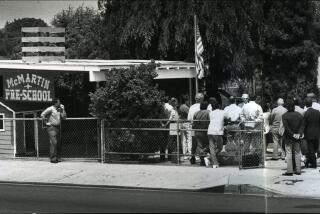Extensive Probe Led to Murder Conviction
GLENDALE — The smirk on Stanley Alan Hershey’s face disappeared quickly after the former Santa Monica teacher was convicted last week in the murder of a retired Glendale accountant whose body has never been found.
Otherwise, the 49-year-old Hershey’s expression remained “very stoic,” his attorney, Jack Suter, said.
After less than five hours of deliberation, a Shasta County Superior Court jury last Thursday found Hershey guilty of killing Gordon T. Johnson, 62, who disappeared in October, 1989, while touring the country in his expensive new motor home--a vehicle, witnesses testified, Hershey had always wanted.
“I didn’t have a lot to work with in this case,” said Suter, a veteran Redding defense lawyer, who called the five-week trial “one of the toughest I have ever had to try.”
Suter called no witnesses. In contrast, the prosecutor, Deputy Shasta County Dist. Atty. William D. Gallagher, presented more than 200 pieces of evidence and called more than 40 people to the stand.
The conviction ended more than three years of investigation by local and federal authorities in six states over the circumstances of Johnson’s disappearance.
Johnson had worked a lifetime to travel the country “like a turtle, with his home on his back” his brother, Del Johnson, 54, said in a 1990 interview. Accompanied only by a mixed black Labrador puppy named Rocky--a retirement gift from co-workers at a subsidiary of Glendale Federal Bank--the vagabond and his dog were last seen camping at Shasta Lake.
A missing persons report filed in Bend, Ore., by Johnson’s relatives led to the discovery of his $219,000 motor home at a resort in Paradise, Ariz., and to the arrests of Hershey and his third wife, Jan, while they were on a spending spree in Las Vegas. In a 1990 federal court trial, the Hersheys were found guilty of stealing Johnson’s motor home, his four-wheel-drive Suzuki and the remainder of his life savings--$120,000.
The murder charge, a state offense, was filed last year. Shasta County officials said they could not remember another murder trial in which a body was not found, but they are certain that, in this case, the victim is dead.
“There was no other possible explanation” for Johnson’s disappearance and the Hersheys’ sudden access to his assets, Gallagher said.
According to testimony, the Hersheys met Johnson at a campground in Minnesota, then followed him across the country to Shasta Lake, where authorities believe Johnson’s body lies.
Key prosecution evidence included journal entries in which Hershey wrote that he had been told by “channelers” from the spirit world to kill Johnson to obtain his motor home.
Referring to “Gordy and his assets,” Hershey wrote that he felt “disbelief” over spiritual orders that contradicted Hershey’s “natural regard for the sanctity of life.” His writings went on to say that spirits had given him “full permission to engage in any activity” including “much that you currently find to be distasteful.”
Suter called the entry “the smoking gun” that led to Hershey’s conviction. “There was nothing I could do to overcome that.”
Jan Hershey, 40, testified in both trials about the couple’s belief in relying on spirits to guide their lives. She also said she believed her husband’s explanation of their new-found wealth--that Johnson had generously given them the use of his motor home and his other assets to carry on their spiritual mission.
Described by authorities as the dupe of her husband, Jan Hershey is serving five years on the federal conviction, while Stan Hershey was sentenced to 20 years in that case. The couple’s child, a daughter, was born just after the federal trial. She is living with her maternal grandparents in New York.
In exchange for her testimony, Jan Hershey was not charged with the murder, which she claims she did not witness. However, after Johnson’s disappearance and before her arrest, Jan Hershey wrote in her own journal that her greatest fears included “jail” and “more assignments (from the spirit world) like the last one.”
Gallagher said he is reasonably certain that Jan Hershey was “a victim of a sinister, diabolical, manipulating” husband. But he added, “You can’t look at all of the evidence without having some concern that Jan Hershey knew what was going on.”
The chain of events that led to last week’s verdict in Northern California began in the mid-1980s--a time when Stan Hershey, who had once taught inmates at San Quentin State Prison, was an investment counselor and was active in community affairs in Santa Rosa.
He also was an avid reader of books about New Age religions and spiritual channeling, the belief that spirits can help determine one’s fate. Suddenly, in 1986, Hershey told his second wife that he was changing his life and wanted a divorce.
Hershey left his wife, a daughter and two stepchildren and moved with three friends to an apartment in West Los Angeles, where the four “frequently channeled together,” recalled apartment manager Melissa Ward in a 1990 interview.
In 1987, Hershey worked briefly as a teacher at Wilshire West, a private Santa Monica school for troubled and learning disabled teen-agers. There he met Jan Vicki Fine, a veteran teacher and counselor.
They married in 1988 and settled in New Orleans, where Stan Hershey was a personal counselor and gave motivational talks on local television. But he was not happy and developed a plan to get a teaching job at a prison in Minnesota, associates said. Spirits would guide them in their quest, Hershey wrote in his journal.
In August, 1989, the Hersheys, driving a modest camper bought with an inheritance Jan Hershey had received, checked into a campground in Apple Valley, Minn. There they met Johnson--on the maiden cruise of his brand-new, diesel-powered Beaver Coach Marquis, equipped with solid oak cabinetry, two television sets, a VCR, and lead crystal in the bar.
To Stan Hershey, it all represented a dream one could kill for. And, because of it, on July 22, he is to be sentenced to life in prison without the possibility of parole. Prosecutors earlier agreed not to seek the death penalty.
More to Read
Sign up for Essential California
The most important California stories and recommendations in your inbox every morning.
You may occasionally receive promotional content from the Los Angeles Times.










